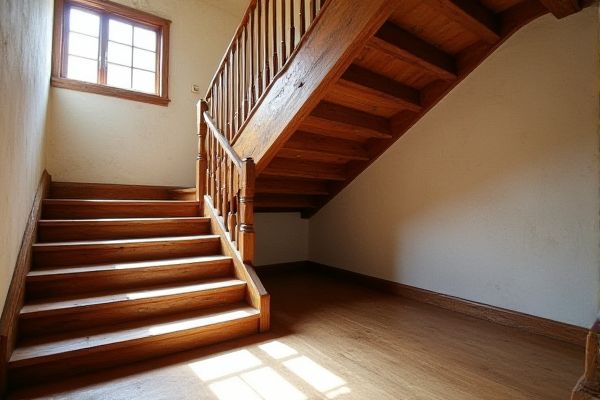
Sunken staircases create a unique architectural feature by descending below the main floor level, offering a sense of depth and enhanced spatial dynamics, while raised staircases elevate above the floor, providing a traditional and prominent ascent. Explore the rest of the article to discover which staircase style best complements your home's design and functionality.
Table of Comparison
| Feature | Sunken Staircase | Raised Staircase |
|---|---|---|
| Design | Steps descend below the main floor level | Steps rise above the main floor level |
| Space Utilization | Efficient for basement or split-level areas | Common in multi-floor buildings, uses vertical space |
| Visibility | Less visible from the main floor, creates a recessed look | Highly visible, serves as architectural focal point |
| Installation Complexity | Requires excavation and structural adjustments | Typically easier to install with conventional framing |
| Safety | Potential tripping hazard due to level difference | Standard design with regulated riser and tread dimensions |
| Applications | Basements, sunken living rooms, and split-level homes | Homes, offices, commercial buildings |
| Cost | Higher due to excavation and reinforcement needs | Generally lower, standard construction methods apply |
Understanding Sunken and Raised Staircases
Sunken staircases are built by lowering the staircase below the surrounding floor level, creating a recessed or indented effect that enhances spatial depth and visual interest. Raised staircases elevate the steps above the surrounding floor, offering a prominent architectural feature and improved visibility from multiple angles. Both designs affect room dynamics and safety considerations, with sunken options often providing a cozy ambiance and raised staircases emphasizing openness and accessibility.
Key Design Differences
Sunken staircases are designed with steps that descend below the main floor level, creating a recessed, often compact feel ideal for maximizing vertical space. Raised staircases elevate above the floor level, offering a more traditional appearance with a prominent, open structure that can enhance the room's aesthetics. Your choice between sunken and raised staircases depends on spatial constraints and the visual impact you want to achieve in your interior design.
Aesthetic Appeal: Sunken vs Raised
Sunken staircases create a dramatic, modern aesthetic by integrating steps below the surrounding floor level, which enhances spatial depth and visual interest. Raised staircases offer a classic, elevated look that emphasizes architectural prominence and can make a bold statement in your interior design. Choosing between sunken and raised staircases depends on your preference for subtle elegance versus striking elevation in your space's aesthetic appeal.
Space Utilization and Layout Impact
Sunken staircases optimize vertical space by creating a recessed area, allowing for a more open floor plan and better flow in compact rooms. Raised staircases elevate the steps above the floor level, which can add visual interest but may consume more usable floor space, potentially limiting furniture placement and traffic patterns. Understanding your layout and space constraints is essential to choosing between these designs to maximize your home's functionality and aesthetic appeal.
Safety Considerations
Sunken staircases pose increased safety risks due to their recessed design, which can cause tripping hazards and reduced visibility, especially in low-light conditions. Raised staircases generally offer better visibility and easier integration of safety features like handrails and non-slip surfaces, minimizing the risk of falls. Proper lighting and clearly marked edges are essential safety considerations for both types to prevent accidents.
Cost Comparison and Installation
Sunken staircases typically incur higher costs due to the need for extensive excavation and structural modifications, increasing labor and material expenses. Raised staircases generally offer a more budget-friendly installation, as they require less groundwork and can be constructed with prefabricated components. Installation time for raised staircases is often shorter, while sunken designs demand careful planning to ensure proper drainage and stability within existing floor levels.
Maintenance and Durability
Sunken staircases often require more frequent maintenance due to their exposure to moisture and potential water accumulation, which can lead to mold and structural damage if not properly sealed. Raised staircases typically offer greater durability by allowing better air circulation beneath the steps, reducing the risk of rot and decay from dampness. Materials like treated wood or metal in raised designs further enhance longevity, minimizing repair costs over time.
Accessibility and User Experience
Sunken staircases offer a unique aesthetic but can pose accessibility challenges due to the additional step down, which may increase the risk of trips and falls, especially for individuals with mobility issues. Raised staircases typically facilitate smoother transitions between levels, enhancing your overall user experience by providing clearer sightlines and easier navigation. Prioritizing accessibility, raised designs often comply better with building codes and accommodate assistive devices, making them a safer choice for diverse users.
Best Use Cases for Each Type
Sunken staircases are ideal for creating dramatic architectural focal points in modern homes or commercial spaces where space optimization and visual impact are priorities. Raised staircases work best in traditional or multi-level layouts, providing clear separation between floors and enhancing accessibility and safety. Both types suit distinct interior design themes and functional requirements, with sunken stairs favored in open-plan environments and raised stairs in classic or formal settings.
Choosing the Right Staircase for Your Space
Choosing the right staircase depends on the spatial layout and aesthetic goals of your home; sunken staircases offer a sleek, modern look that maximizes vertical openness, making them ideal for contemporary, compact spaces. Raised staircases provide a traditional, commanding presence, suitable for homes with higher ceilings or where under-stair storage is desired. Evaluating ceiling height, available floor area, and lighting can help determine whether a sunken or raised staircase best optimizes functionality and visual appeal.
 homyna.com
homyna.com